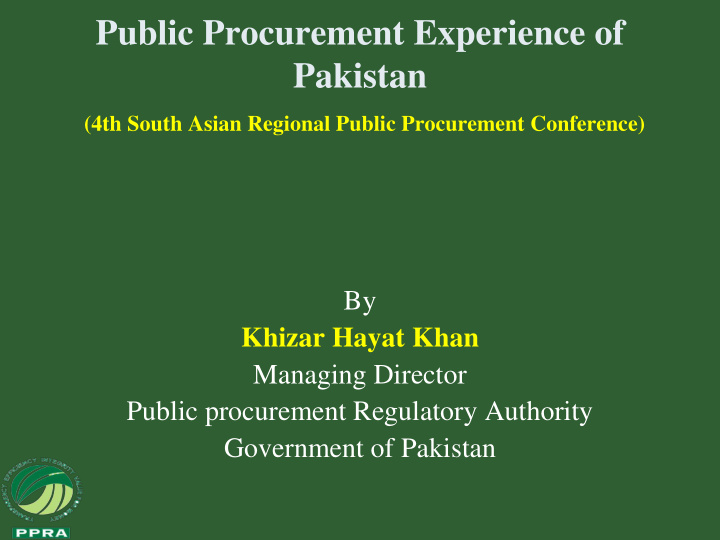



Public Procurement Experience of Pakistan (4th South Asian Regional Public Procurement Conference) By Khizar Hayat Khan Managing Director Public procurement Regulatory Authority Government of Pakistan
Sequence of Presentation 1. Regulatory Structure 2. Performance at a glimpse 3. Initiatives 4. Way forward 2
Public Procurement Regulatory Structure of Pakistan • Federal Public Procurement Ordinance 2002 and Public Procurement Rules 2004 • Sindh Public Procurement Act 2009 and Rules 2010 • Punjab Public Procurement Act 2009 and Rules 2014 • KP Public Procurement Act 2012 and Rules 2014 • Balochistan Public Procurement Act 2009 and Rules 2014 3
Management and Administration of the Authority Composition of the Federal PPRA Board: (1) Secretary, Finance Division (Chairperson) (2) Secretary, Ministry of Industries and Production (Member) (3) Secretary, Defence Production Division (Member) (4) Secretary, Ministry of Water and Power (Member) (5) Secretary, Ministry of Housing and Works (Member) (6) Secretary, Ministry of Communications (Member) (7) Three Members from private sector (Member) (8) Managing Director (Member) / Secretary 4
Performance of PPRA 271876 tenders monitored/uploaded on PPRA website during the Financial Years 2004-2016 Financial Tender Uploaded Average Daily PP Rules Organizations % Violations Year Tenders Violations 2004-05 255 11905 32.62 11311 95.01 2005-06 274 17124 46.92 12782 74.64 2006-07 293 20226 55.41 13657 67.52 2007-08 295 17078 46.79 9917 58.07 2008-09 290 17913 49.08 4720 26.35 2009-10 350 18404 50.42 3883 21.10 2010-11 385 20880 57.21 2738 13.11 2011-12 582 24104 66.04 2506 10.40 2012-13 677 26122 71.57 5721 21.90 2013-14 742 28046 76.84 4458 15.90 2014-15 755 31844 87.24 4304 13.52 2015-16 761 38230 104.74 4054 10.60 5
Performance of PPRA • After uploading of PP Rules Violations at PPRA website in Financial Year 2017 the Compliance of PP Rules increased from 1% to 30%. • Procurement Plans of 174 Federal Procurement Agencies were uploaded during the current financial year. 6
Initiatives 1. Harmonization 2. Procurement Professionalization 3. E-procurement 4. Procurement MIS 7
Harmonization An Advisory Group formed by heads of all PPRAs formed which aims to: i. Harmonize the procurement rules ii. Use single set of Standard Bidding Documents across the county iii. Use unitary e-procurement system National Procurement Strategy 2013-16 is being updated in March to adjust these milestones. 8
Procurement Professionalization Mandatory Certification for procurement Professionals • PPRA is – developing a menu of training modules (online free of cost, half day, one week, three weeks) – Partnering with public and private sector academic institutions to offer certified programs for officials of implementing entities 9
Procurement Professionalization • Placing Procurement courses at public service entry level training • Coordinating with Higher Education Commission to introduce courses at degree level in various disciplines 10
E-Procurement • Federal and some provincial PPRAs have adopted the e-procurement strategy • For implementation, as the first step the procurement module available in the Financial Management System is activated to link budgets with procurement plans and register payments for selected set of procurements. 11
Procurement MIS • Two of the provincial PPRAs have developed and are running MISes which require entities to upload data for procurement plans linked with budget activities, procurement procedures, advertisement, bid submittal date and other details, summary of evaluation, contract award, and contract completion information • PPRAs will use this data for performance analysis 12
Way Forward • Developing a full fledged e-procurement system for large contracts dovetailed with the Accounting system 13
Thanks 14
Recommend
More recommend